29: James English
An overview of the courts and aces of spades produced by James English
James English was one of a number of makers who took up card-making after the duty was reduced to 3d in 1862. From 1854 he was a pasteboard maker and playing cards are first mentioned in 1865. His court design is based loosely on that of De La Rue, but interestingly he only produced courts with all twelve suit-signs on the left, a feature which doesn't appear in De La Rue's cards until 1870 at the earliest. There are two versions of the courts, the later one slightly smaller than the first, no doubt to give more room to indices, plus a patience version. At some point in the 1880s the playing card division changed its name to Peerless Card Company, after the name of the factory in which they were produced, though boxes often have James English on them and they are always listed in the directories under the latter name. They continued production until c.1904 (I still have to check the last mention in the directory). However, they were still listed as pasteboard makers in 1939.
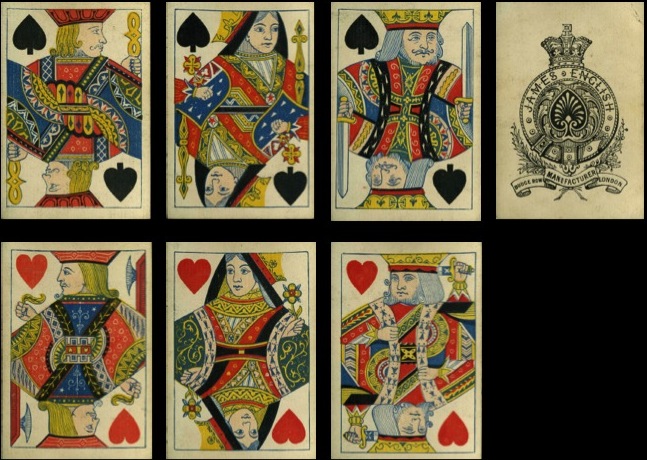
Above: E1 courts with coloured faces and the first AS, c.1865

Above: top: the second AS and first courts (E1), c.1867-70; bottom: various later aces and an early indexed pack with E2 courts, c.1880. These indices were also used with E1 courts, but in the case of the court cards they were inside the frame.
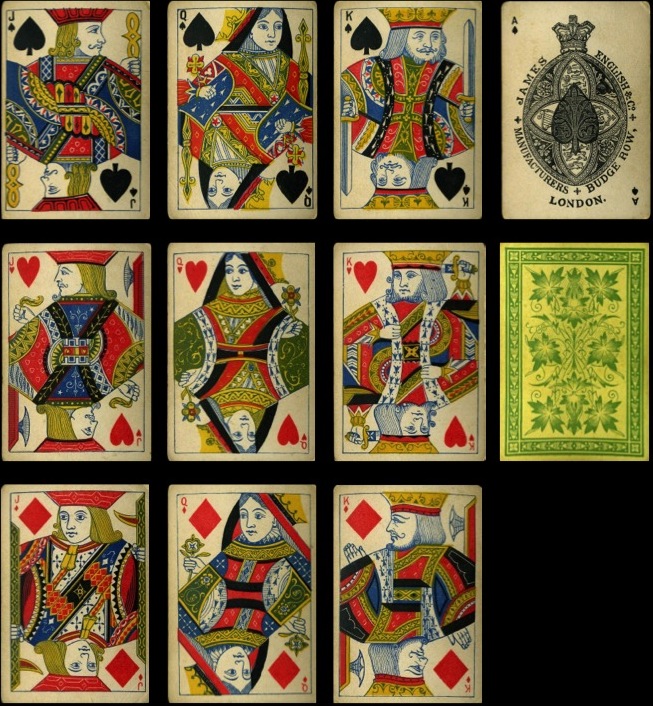
Above: c.1880

Above: top: E2 courts with Peerless AS and different indices; bottom: E1 courts in one colour only for a transparent pack published by Houdin, Paris. See also page 15 on playing card oddities►
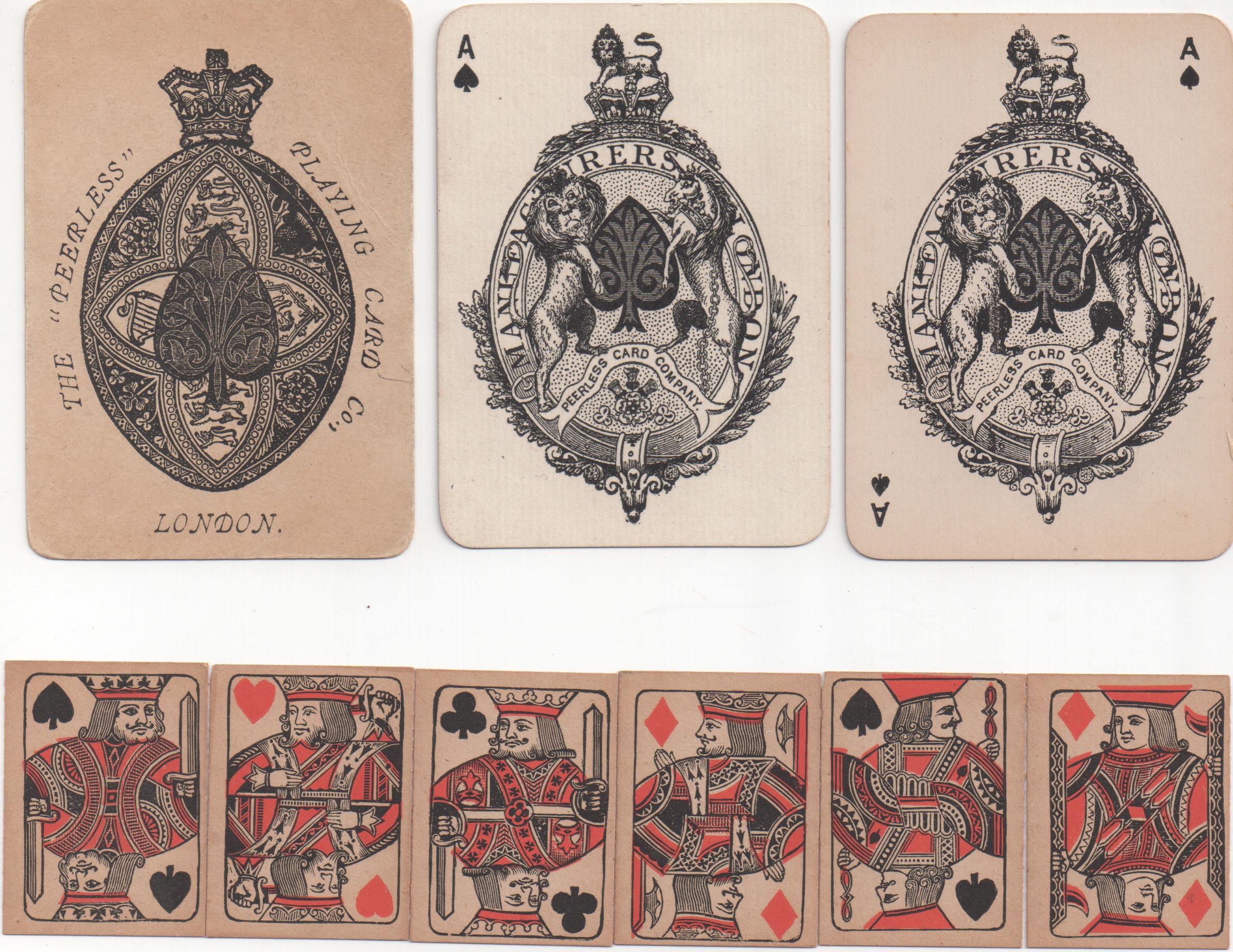
Above: top: an early Peerless AS with 'PLAYING' in the title; two examples of the rather sloppy output of some of the cards: only one index and the indices in the wrong corners; bottom: the patience version.
The sloppiness of some of the production in later years and the cheap quality of the cards can be seen in the indices. They seem to have been two separate pieces of print, unlike in most cases where the index and the pip were one piece of removable type. The commoner of the two types of index was differentiated as to the suit colour after the first use of them with indices within the court frame line. Even in the earliest packs the red numbers were often different in different packs, presumably indicating wear and tear. Note the different shapes of the numbers in the diamonds of two such packs; this is not a question of different ends, because neither end matches the other.

Then the slightly later packs with E2 courts had different numbers in the hearts and diamonds on the one hand from the spades and clubs on the other. The examples below are from the same pack.

At some point, possibly as late as the 1890s, a slender type of index was used, similar to that of Goodall's from the same decade.
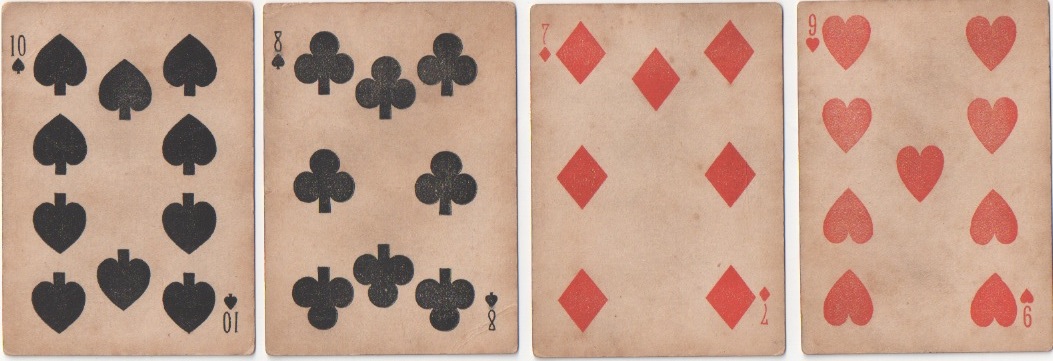 These number cards are from the same pack as the courts illustrated above. Note the poor quality card.
These number cards are from the same pack as the courts illustrated above. Note the poor quality card.
Finally, in another poor quality pack (in very poor condition) the slender indices are in the red suits and the older type are in the black suits. There's no evidence that this is a mixed pack.
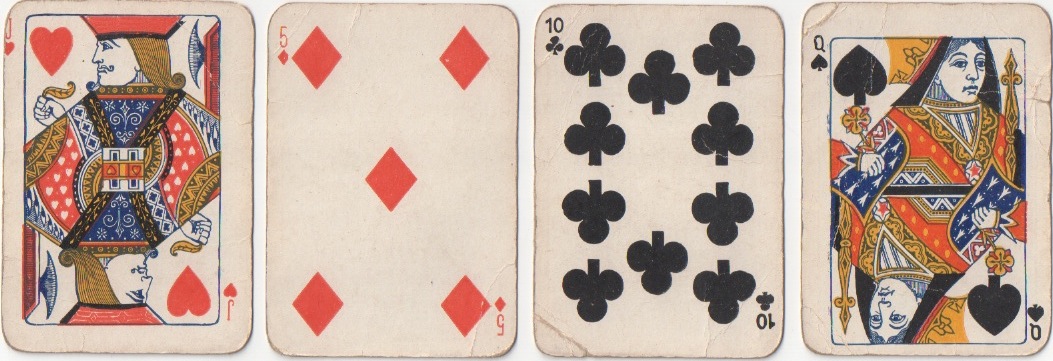
Like many of the makers at this time English produced a range of decorative backs, some of which were of a very high standard in the early stages of the firm's production. I give a small selection below. Although it's not listed in John Berry's book on tax wrappers and aces of spades, there is a wrapper with James English on, as shown below.

Above: decorative back designs and wrapper with address.
For a list of the packs in my collection by this maker, click here►
For the only known non-standard pack by this firm, see Peerless Playing Card Company►
By Ken Lodge
United Kingdom • Member since May 14, 2012 • Contact
I'm Ken Lodge and have been collecting playing cards since I was about eighteen months old (1945). I am also a trained academic, so I can observe and analyze reasonably well. I've applied these analytical techniques over a long period of time to the study of playing cards and have managed to assemble a large amount of information about them, especially those of the standard English pattern. About Ken Lodge →

Leave a Reply
Your Name
Just nowRelated Articles

78: The Standard English pattern - Part 2, the tricky bits
There are many less straightforward aspects to the designs of the English pattern, which need carefu...

76: Transitions: Hunt & Sons
Styles change and technology develops. This means that it's possible to see transition periods in th...
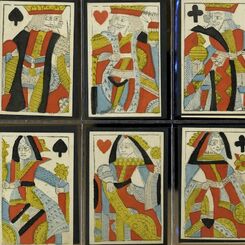
70: Woodblock and stencil : the spade courts
This is a presentation in a more straight forward fashion of the work done by Paul Bostock and me in...

69: My Collection
This is an archive list of my collection. I hope it will be of use and interest to others.

50: Joseph Reynolds
A presentation of my database of Reynolds cards.

47: Welch’s postcards and De La Rue’s redrawing
There are a number of court card designs that have never actually been produced as cards. It's a sha...
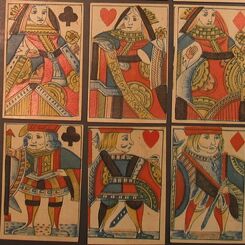
46: Henry Hardy, Henry French & Christopher Groser
A brief look at some makers of whom we know little.

39: Mixed Packs
A number of mixed packs appear for sale from time to time, but it's important to sort out what is me...

35: More Design Copies
Here I want to take another widely copied design and see how individual variation by the copier can ...

32: The Not-So-Minor Cardmakers of the 19th Century - Part 3
A survey of the cards made by Creswick and Hardy, with a brief mention of De La Rue, Goodall and Rey...

31: The Not-So-Minor Cardmakers of the 19th Century - Part 2
This page continues the presentation of examples of the major English cardmakers of the 19th century...

17: Waddington, Including some of their Less Common Packs
John Berry's two-volume work on the Waddington archive and collection is a very comprehensive presen...

5: De La Rue
In December 1831 Thomas de la Rue was granted his patent for printing playing cards by letterpress.
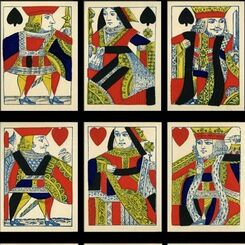
2: Still Collecting Playing Cards at 80
This is a personal account of some of my experiences collecting playing cards.
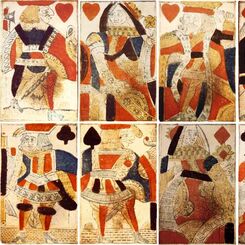
Hunt, c.1800
Standard English pattern playing cards manufactured by Hunt, c.1800.

James English & Co.
Victorian Playing Cards manufactured by James English & Co., London, c.1875
Most Popular
Our top articles from the past 60 days


 Your comment here. Your comment here. Your comment here. Your comment here. Your comment here. Your comment here. Your comment here. Your comment here. Your comment here. Your comment here. Your comment here. Your comment here. Your comment here. Your comment here. Your comment here. Your comment here. Your comment here. Your comment here. Your comment here. Your comment here. Your comment here. Your comment here. Your comment here. Your comment here. Your comment here. Your comment here. Your comment here. Your comment here. Your comment here. Your comment here. Your comment here. Your comment here.
Your comment here. Your comment here. Your comment here. Your comment here. Your comment here. Your comment here. Your comment here. Your comment here. Your comment here. Your comment here. Your comment here. Your comment here. Your comment here. Your comment here. Your comment here. Your comment here. Your comment here. Your comment here. Your comment here. Your comment here. Your comment here. Your comment here. Your comment here. Your comment here. Your comment here. Your comment here. Your comment here. Your comment here. Your comment here. Your comment here. Your comment here. Your comment here.
























